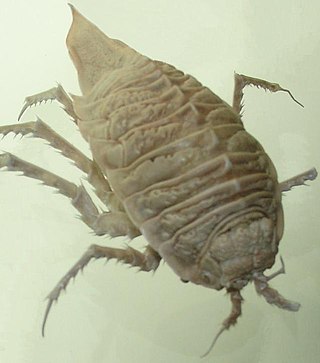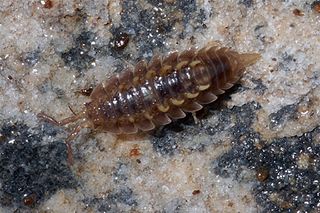
Félix Édouard Guérin-Méneville, also known as F. E. Guerin, was a French entomologist.

Isopoda is an order of crustacean, which includes woodlice and their relatives. Members of this group are called Isopods and include both terrestrial and aquatic species. All have rigid, segmented exoskeletons, two pairs of antennae, seven pairs of jointed limbs on the thorax, and five pairs of branching appendages on the abdomen that are used in respiration. Females brood their young in a pouch under their thorax.

Phronima is a genus of small, deep sea hyperiid amphipods of the family Phronimidae. It is found throughout the world's oceans, except in polar regions. Phronima species live in the pelagic zone of the deep ocean. Their bodies are semitransparent. Although commonly known as parasites, they are more technically correctly called parasitoids. Instead of constantly feeding on a live host, females attack salps, using their mouths and claws to eat the animal and hollow out its gelatinous shell. Phronima females then enter the barrel and lay their eggs inside, then propel the barrel through the water as the larvae develop, providing them with fresh food and water.

The Valvifera are marine isopod crustaceans. Valviferans are distinguished, however, by the flat, valve-like uropods which hinge laterally and fold inward beneath the rear part of their bodies, covering the pleopods. Some species are omnivorous, and serve as effective scavengers in the economy of the sea.

A woodlouse is any crustacean belonging to the suborder Oniscidea within the order Isopoda. They get their name from often being found in old wood, and from louse, a parasitic insect, although woodlice are neither parasitic nor insects.
Iais is a genus of isopod crustaceans. Iais species are found in association with larger isopods of the family Sphaeromatidae, usually on the ventral surface of the larger animal, between the pereiopods and on the pleopods. They are native to Australasia and South America, although Iais californica and its host Sphaeroma quoyanum have invaded California, and I. californica was first described from Sausalito, California. Nine species are recognised:

The Idoteidae are a family of isopod crustaceans. It includes these genera:

Agnaridae is a family of woodlice. They were formerly considered part of the Trachelipodidae, but were moved from that family to Porcellionidae in 1989, and then placed as a separate family in 2003.

Dynoides elegans is a species of isopod crustacean in the genus Dynoides. It was originally described in 1923 by Pearl Lee Boone as "Cianella elegans" based on specimens from La Jolla and San Pedro, California. It was transferred to the genus Dynoides in 2000, when Boone's genus was sunk into synonymy with Dynoides.

Hemerobius is a genus of lacewings in the family Hemerobiidae. It is found throughout Europe and North America. Like most lacewings, both the larvae and adults are predatory, primarily eating acarines, scale insects, psyllids, aphids, thrips, and the eggs of lepidopterans and whiteflies.

Aega is a genus of isopods in the family Aegidae, containing the following species:

Thomas Norris FRAS was an English businessman, art collector, natural historian and astronomer, born at Croston in Lancashire. Joining the Bury firm of Peel, Yates and Co. as a book-keeper at the age of twenty, he eventually became a partner and amassed a considerable fortune from its success in the textile and calico-printing businesses. Amongst his partners at the firm was the businessman and politician Sir Robert Peel, whose son, also named Sir Robert Peel, served twice as Prime Minister of the United Kingdom. Norris was reputedly a regular and welcome visitor at the latter's home in Whitehall Gardens.

Nerocila is a genus of parasitic isopod crustaceans, with 11 species, which have been found parasitizing Indian marine fishes.

Deto echinata, the horned isopod, is a species of air-breathing isopod, or woodlouse, in the family Detonidae. It inhabits seashores in southern Africa and on some oceanic islands.
Annobodillo is a genus of armadillo woodlice, terrestrial crustacean isopods of the family Armadillidae. The only species within the genus is Annobodillo coecus, which is endemic to the island of Annobón in Equatorial Guinea. The species and the genus were described in 1983 by Helmut Schmalfuss and Franco Ferrara. The name of the genus Annobodillo refers to the island Annobón.
Paraxenodillo is a genus of armadillo woodlice, terrestrial crustacean isopods of the family Armadillidae. The only species within the genus is Paraxenodillo singularis, that lives in the island of Annobón in Equatorial Guinea. The species and the genus were described in 1983 by Helmut Schmalfuss and Franco Ferrara.

Detonidae is a family of woodlice in the order Isopoda. There are at least 3 genera and more than 30 described species in Detonidae.

Echiuridae is a family of spoon worms in the suborder Echiurida. It is a monotypic family, the only genus being Echiurus. These worms burrow into soft sediment on the seabed.
Deto aucklandiae is a species of seashore dwelling woodlouse from the Detonidae family. D. aucklandiae is endemic to a few subantarctic islands in New Zealand.















